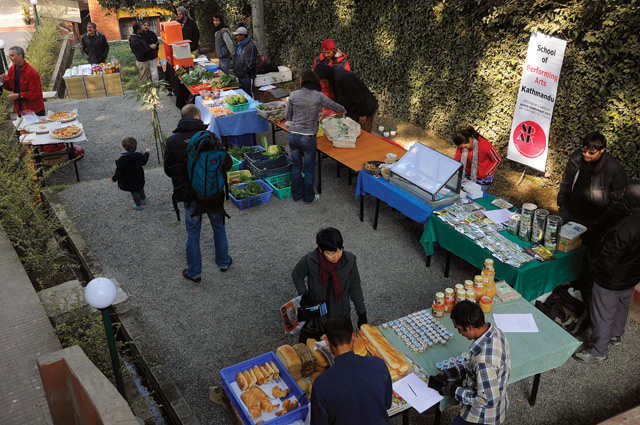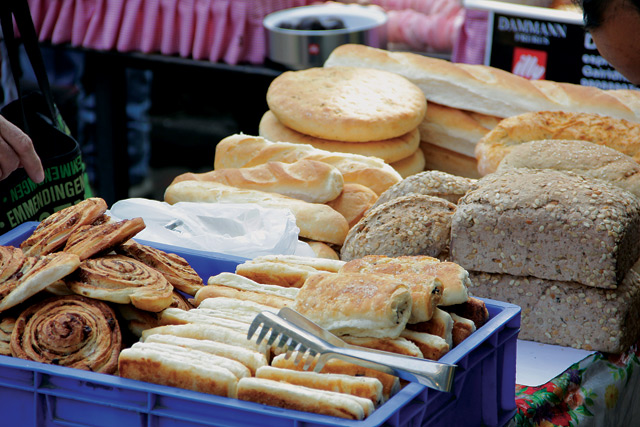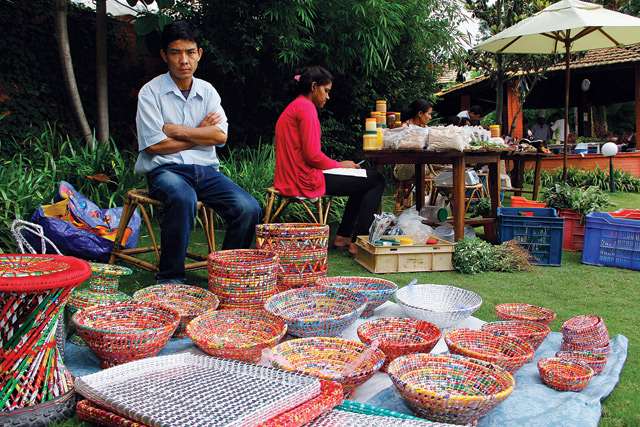Of late, a few entrepreneurs in Kathmandu have been trying to foster a culture of farmers’ markets offering fresh produce and organic goods. A connoisseur of such markets, Michael Rosenkrantz, offers valuable insight and advice on this growing trend.
“It’s okay if vegetables are less green. People are used to (buying) shiny things, but don’t know what they’re eating.” - Shoba Rayamajhi, Owner/Manager 1905 Restaurant Farmers’ Market
In Kathmandu, more “Westernized” styles of farmers’ markets, although still in their infancy, are slowly becoming part of the landscape. The most successful of these being the 1905 Restaurant in Kantipath, followed by the new Yellow House Market in Sanepa, the Trisara Restaurant Market in Lazimpat, the Hotel Summit Organic Market and a new market at Flavor’s Restaurant in Boudha.

As a person who has been intimately involved with farmers’ markets in the United States, I can’t speak enough about my love and passion for these delectable social and economic entities. In my travels, especially in India and Nepal, I’ve always been on the lookout for such places.

Farmers’ markets have been an integral part of the history of human beings. They are a venue for not only purchasing food and other items, but also for connecting with others. These places can help build and empower the communities they are located in, and this should not be taken for granted. Creating “ownership” on the part of customers, vendors and market coordinators/managers is vital for success. There is little doubt that markets help people become more connected to their communities. Managers need to be mindful of this and constantly think about how to also connect with the larger community, e.g. by putting up message boards, information about local events and newsletters in the market.

Markets, of course, are all about fresh food, the colors and smells of fruits and veggies (conceivably picked that morning), the taste of fresh sauces and baked goods, cheese, fish, and free-range organic meats. They are truly democratic institutions and egalitarian with all types of people being on equal footing. As markets become more deeply rooted in a community and continue for longer periods of time, they become part of a larger family tradition.
Farmers’ markets not only bring fresh, organic, nutritious food to urban dwellers, but can also turn underutilized public spaces into community gathering places. NGOs, as well as local businesses, can use the opportunity to create awareness about their social missions. In the Kathmandu markets, I observed the KAT Centre, SAATH and Tipling Basket Weavers educating people about their work. The Trisara Market was started a number of months ago by Pushpa Basnet of Early Childhood Development Center (ECDC) in order to generate funds for the NGO. Flavor’s Café and Restaurant supports an NGO helping street dogs and their employees include Persons with Disabilities. This shows a real social consciousness on the part of the host restaurants. Markets are also about incubating businesses, trying out new ideas and products.

Unlike the majority of markets in the US, those in Kathmandu are held on private property and can be viewed as a method of increasing opportunities for the main business i.e. the restaurants. However, it might be difficult at this point to install farmers’ markets in public spaces due to government bureaucracy and/or the lack of regulations regarding this type of activity.

Because of their locations, the Kathmandu markets seem generally geared towards expats, although I was told that there has also been outreach towards locals. According to Shoba Rayamajhi, the Owner/Market Manager of 1905, one of her biggest challenges is getting Nepalis to visit. On more than one occasion, I was told that the products being offered were not necessarily eaten on a large scale by Nepalis and that the prices were higher than in local bazaars. Rayamajhi suggested that the higher prices were related to fuel costs, and the fact that organic farms were much smaller in scale than those catering to mass markets. However, in general, people native to this part of the world have traditionally shopped at smaller neighborhood markets or from street vendors. But, as also witnessed by the establishment of Big Mart, Saleways and Bhat Bhateni stores, there is a movement towards a more Westernized style of one-stop shopping. There is also a great need to educate people about the benefits of eating organic foods. In a sense, this is ironic since all foods grown were organic before the advent of large scale chemical/pesticide companies.
As people have become more concerned about what they eat and somewhat move away from factory farming, the number of community based farmers’ markets in the US has increased exponentially. This is also based on movements for real food, such as Slow Food, Edible Gardens and community and school gardens. These movements have tremendous implications for Nepal in growing and maintaining fresh food and keeping away from mass produced goods. An example of this are the number of “kitchen gardens” in Kathmandu city. Additionally, Voluntary Service Overseas (VSO), the INGO that brought me to Nepal, is using school gardens and organic growing methods as an entry point for working with communities. This has potential implications for health, education and livelihoods in breaking the cycle of poverty.
The Kathmandu markets are all somewhat similar in their roots. For instance, the Yellow House Market, established in October 2013, was a way of helping people make the connection between their organic breakfast and the farmers growing/producing vegetables and fruit. The 1905 Market began in 2010 to provide an outlet for organic produce, meats and cheese. Trisara’s market was started in order to support the NGO ECDC, but is also a platform for providing local organic products. The Summit Hotel Market touts itself as the first organic bazaar in Kathmandu. According to Anil Yonzon, Director of Flavor’s Market, their idea was to create an outlet for promoting organic products in Bouddha.
Nayantara Gurung Kakshapati, Market Director of the Yellow House Market, told me that there is a growing interest in organic and local produce but not enough outlets. Kakshapati decided to open the Yellow House Market because there weren’t many such bazaars in the southern part of Kathmandu. The Yellow House Market regularly has about 15 vendors. In December, they also allowed non-food retailers, e.g. an NGO selling hand knit clothing and a book seller. Kakshapati hopes to allow non-food vendors set up shop twice or thrice a year and also intends to promote NGOs. Although the customers were primarily expats, the majority of vendors were Nepali, thus enabling farmers to have more outlets such as weekly markets. There is also a low entrance fee, giving them direct access to customers without losing profit to middlemen.
In Nepal, organic verification is done through Organic Certification Nepal (OCN). However, during 2014 the Ministry of Agriculture, through the National Organic Agriculture Accreditation Body (NOAAB), will be working with OCN and a Participatory Guarantee System (PGS) to ensure that farmers, or groups of farmers, can receive an organic certification document. This is good news for consumers as they will be assured that products touted as being organic are, in fact, just that. At the same time, the government should also ensure that only local products are put on sale. Farm inspections by individual markets can also be conducted to determine how “organic” products are actually grown.
Similar to the US, there is a need to maintain the younger generation as farmers. In Kakshapati’s opinion, most youngsters don’t want to farm. “But we need to make farming a cool thing to do,” she adds. “The urban youth seem to be getting more interested in farming with small markets being an outlet. We need to build the profile of farming as a legitimate profession.” An example of this is the Srijana Farm in Palpa.
When I visited Trisara, I saw very few customers. There was a very inviting hand-painted sign on the road, but the actual market was located deep inside the restaurant compound. This raised a question: How can farmers’ markets market themselves? There’s always Facebook, which Market Manager Arun Shrestha uses to attract regular restaurant customers to the bazaar, but having the market and its vendors visible from the main road would be an even bigger advantage. This same idea can be taken up by the other markets. Having the right mix of vendors so that customers can do all their shopping in one stop is also extremely important. Another thing I observed was that none of the markets sold fish or flowers which is something that can be worked upon.
The most successful market was located at the 1905 Restaurant. Since Shoba Rayamajhi’s family owns a farm, and she knew both Nepalis and expats who were interested in organic products, she wanted to create a space to connect the two. Rayamajhi is very serious about the 1905 Market and has sacrificed bigger parties and the revenues they would have brought, for holding the market every Saturday, rain or shine, monsoon or winter. The manager looks for products that are organic, but in consumer goods, e.g. jewellery or pottery, she searches for those that are creative and environmentally friendly, creating a very balanced vendor mix.
Rayamajhi understands food movements and value chains and has a bigger picture in mind. She has started with branding her more than 100 year old family farm, Dhokadi; creating a farm stay, further connecting people to the place where their food is grown. The farm produces, among other things, unbleached wheat, mustard, flack seed and buckwheat. They also raised free range turkeys for Thanksgiving. Rayamajhi also wants to create a model village based on good farming practices. She spoke to me about Good Agricultural Practices (GAP) and is working with the Government in bringing these to Nepal. Still, she feels that more awareness needs to be created, growing more in Nepal and not importing as much food from other countries.
I also spoke to a number of vendors to find out their opinions. Sushil Khanal has been farming for nine years after spending years in the tourism industry. He changed professions because farming is his passion. Khanal drives two hours from his farm in Nagarkot to get to both the 1905 Market on Saturdays and the Yellow House Market on Sundays. He does this to acquire new contacts and because it is a good advertisement for his farm. Rasmita Baniya of Vienna Bakery sells unique breads, e.g. rye, made from organic flour, at both markets and hopes to sell more at others when they come into existence. The Sri Aurobindo Yoga Mandir, which includes an organic farm and a home for orphans, also offer their products at three markets.
The Flavor’s Market featured seven vendors including Mr. Pemba (Sangam) Sherpa of, who has a background in tourism but has combined this experience with his Organic Farmhouse in Kapan. Sherpa is new to the field, this being his first farm in Kathmandu. He employs a number of women and other former rural dwellers who came to the capital looking for employment. He is trying to get Nepalis to eat more leafy green vegetables, high in vitamins and minerals, all uncooked. He feels this will help reduce stomach problems. Sherpa has brought seeds from the Netherlands and has had bio-organic training. Another interesting vendor was Sudarsan Karki of Kavreli Family Farm in Kavre who sets up shop at Flavours and Trisara Markets. His only product was something called Ground Apple, a cross between a pear and an apple, but looking more like a sweet potato.
While talking to customers, an expat revealed that he felt the market had too many foreigners, that many of the vegetables being sold targeted this community and that there should be more of a balance in the offerings. Ambica, a Nepali lady who was accompanied by her expat friend Diana, a resort owner in Indonesia, told me that she has been coming to the 1905 Market since its inception. Diana, who visits Nepal twice or thrice a year, stated that she always made it a point to shop at the 1905 Market and take products back to Indonesia.
Everything considered, it makes sense to support local (organic) farmers, whether they sell at weekly markets or on the streets. The problem on the streets, though, is the middlemen who take up most of the profits. The best bet then is to visit local farmers’ markets since purchasing products directly from the farmers creates a sound local food movement throughout the country.
Good to know
The Yellow House, Sanepa, every Sundays 9 AM-12 PM. What you can find: Organic produce, avocado, lettuce, carrots, Jumla apples, kiwi, baked goods, jams, honey, meat, rice, pasta are available here.
1905, Kantipath. Saturdays 9 AM- 1 PM. What you can find: Organic produce, a variety of meats and cheese, various types of honey including Butter nut honey and Everest honey, Soap-nut jewellery and even distilled cow urine (offered as a therapy for a variety of ailments including cancer, diabetes, asthma, etc).
The Summit Hotel, Kupondole, Sundays/Wednesdays 10 AM-12:30 PM. What you can find: Organic vegetables and other eco-friendly and/or homemade produce. Some gift items, fresh bakery items, coffee, tea and something special for the kids.
Trisara, Lazimpat, Saturdays, 11 AM-2 PM. What you can find: The newest of the markets has a total of eight vendors, half of whom sell produce.
Flavor’s Restaurant and Café, Boudha, Saturdays 8 AM-1 PM. What you can find: Organic produce (beets, salad greens, parsley, celery, kiwi, tomatoes, ground apple, dried mushrooms), baked goods (cookies-oatmeal chocolate chip walnut, strawberry white chips, chocolate chip, breads); corn flower, jams, pickles, honey, pasta, buff sausage, Pokhara (feta) and goat cheese.










